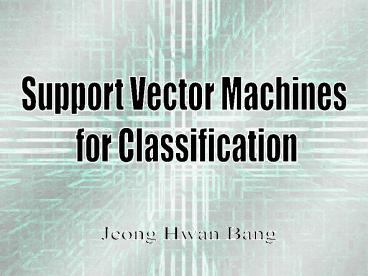Support Vector Machines - PowerPoint PPT Presentation
Title:
Support Vector Machines
Description:
Information is received at the synapses on its dendrites ... The goal is to classify the class of an iris given two features - pedal length and pedal width ... – PowerPoint PPT presentation
Number of Views:18
Avg rating:3.0/5.0
Title: Support Vector Machines
1
- Support Vector Machines
- for Classification
- Jeong Hwan Bang
2
- Overview
- Theory
- Simulations
- Applications
3
- Artificial Neural Networks
- Analytic techniques modeled after the processes
of learning in the cognitive system and the
neurological functions of the brain - Capable of predicting new observations from other
observations
4
Model of a Neuron
- Information is received at the synapses on its
dendrites - An electro-chemical transmission occurs at the
synapses - At the cell body, a summation of the electric
impulses takes place - If summation meets a particular threshold, the
neuron will send a signal
5
- Simplified Model of A Neuron
6
Artificial Neuron
- Receives a number of inputs
- Each input has a weight that corresponds to
synaptic efficacy in a biological neuron - Weighted sum of the inputs is formed
- Activation if weighted sum meets the threshold
value
7
- Model of an Artificial Neural Network
8
Support Vector Machines
- Extensively used for classification and
regression problems - Does not suffer the curse of dimensionality
- Valuable for solving problems with a large number
of inputs
9
SVM Theory
- Maximize the margin between the separating
patterns using a hyperplane - Margin of separation is the separation between
the hyperplane and the closest data point - The goal is to find the optimal hyperplane to
maximize the margin of separation
10
SVM Theory
11
SVM Theory
- Support vectors are data points that lie directly
on the decision boundary - Support vectors serve a very important role in
the operation of this algorithm
12
- SVM Theory
13
SVM Theory
- Slack variables consider the case of nonseparable
patterns, and measure the deviation of the data
points from the boundary of the region of
separability
14
- SVM Theory
15
Optimization Problem
- Given the training example
- Find the optimum values of the weight vector and
bias such that they satisfy the constraint
16
Optimization Problem
- Minimize the cost functional
- The parameter C quantifies the trade-off between
training error and system capacity
17
Inner-Product Kernels
- The inner-product kernel may be used to construct
the optimal hyperplane in the feature space
without having to consider the feature space
itself in explicit form - The requirement on the construction of the kernel
is that it satisfies Mercels theorem
18
Inner-Product Kernels
- polynomial learning machine
- radial-basis function network kernel
- two-layer perceptron kernel
19
Simulations
- Linearly Separable Data
- Nonlinearly Separable Data
- Polynomial Mapping
- Classification Example
20
- Linearly Separable Data
21
- 5
- Nonlinearly separable data, C 10
22
- -8
- Nonlinearly separable data, C 10
23
- Polynomial Mapping
24
Classification Example
- The goal is to classify the class of an iris
given two features - pedal length and pedal width
25
- Separation of the Setosa class
26
- Polynomial SVM of degree 2, C ? Infinity
27
- Polynomial SVM of degree 10, C ? Infinity
28
- Polynomial SVM of degree 10, C 10
29
Applications
- Nonlinear Equalization
- Text Categorization
- 3D Object Recognition
30
- Nonlinear Equalization
- Output of a channel is used as the input of the
classifier - Channel output is transformed into a pattern
space, which is mapped into a higher-dimensional
feature space - Classifier matches a delayed version of the
original signal
31
- Text Categorization
- Utilizing Information Retrieval Theory, word
stems are used as representation units - Each distinct word corresponds to a feature, with
the frequency of occurrence as its value - To avoid an unnecessarily large number of
features, only words of a threshold frequency are
considered, and stop-words (and, or, etc.)
are ignored
32
- 3D Object Recognition
- Many views of an object are given to the SVM
- Types of features selected
- Shape of the object
- Color of the object
- Shape and the color of the object
33
Conclusion
- Support vector machines method is an efficient,
robust method for classification - Advantages
- Small number of adjustable parameters
- Doesnt require prior information or heuristic
assumptions - Train with relatively small amounts of data
34
- THANK YOU
- THANK YOU































